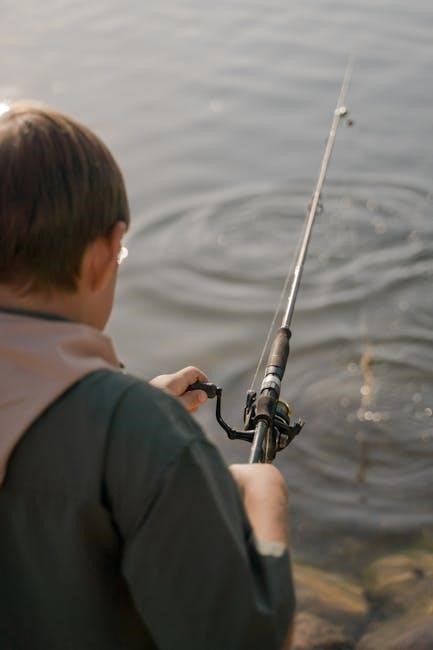Fishing rod guides play a crucial role in enhancing casting accuracy, line control, and sensitivity. They direct the line flow, reducing friction and improving overall performance. Properly designed guides ensure smooth energy transfer during casts and fights, making them essential for both beginners and experienced anglers. Available in various materials and sizes, they cater to different fishing styles and conditions, ensuring optimal functionality across diverse fishing scenarios.
1.1 Importance of a Well-Designed Fishing Rod
A well-designed fishing rod is essential for maximizing performance, accuracy, and sensitivity. It ensures optimal energy transfer during casting and fighting fish, reducing fatigue and improving overall control. A balanced design enhances comfort, allowing anglers to fish for extended periods without strain. Properly constructed rods also minimize line friction, enabling smoother casts and better hook sets. Additionally, a well-designed rod is durable, withstanding the rigors of frequent use and harsh environments. Ultimately, it enhances the angler’s experience, increasing the chances of a successful and enjoyable fishing trip. A quality rod is an investment in both functionality and long-term fishing satisfaction.
1.2 Brief History of Fishing Rod Development
Fishing rods have evolved significantly over centuries, reflecting advances in materials and design. Early rods were made from wood or bamboo, offering simplicity and durability. The mid-20th century introduced fiberglass rods, known for their strength and versatility. Later, graphite rods became popular for their sensitivity and lightweight feel. Modern rods often combine materials, blending fiberglass and graphite for optimal performance. Historical innovations, such as the development of guides and reel seats, have further refined rod design. Today, rods are tailored to specific fishing styles, ensuring anglers have tools suited to their needs, whether freshwater, saltwater, or specialized techniques like fly fishing.
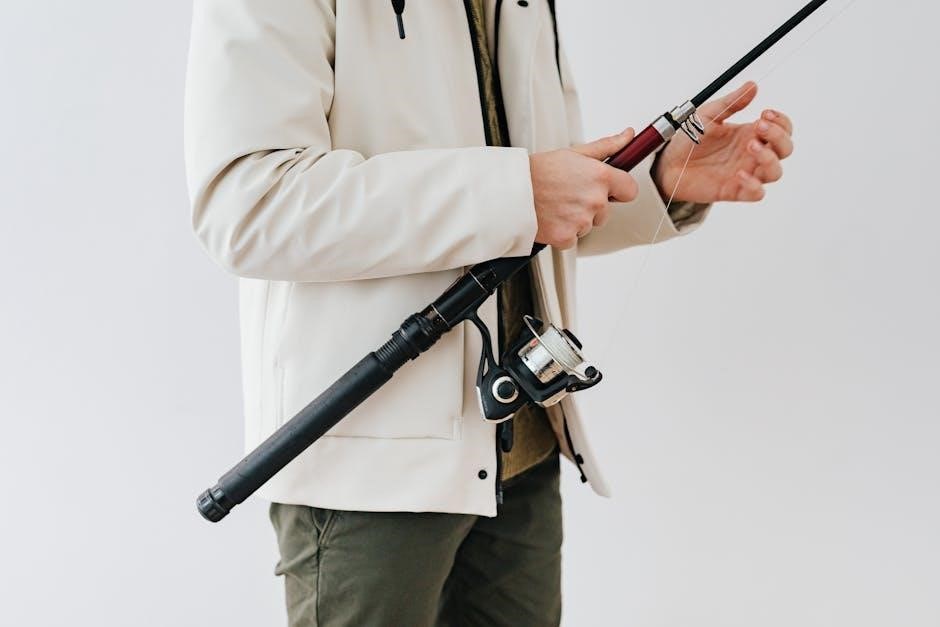
Understanding Fishing Rod Components
Fishing rods consist of a rod blank, guides, reel seat, and grip. Each component contributes to casting, line management, and overall fishing efficiency, ensuring balance and optimal feel for anglers.
2.1 The Role of the Rod Blank
The rod blank is the backbone of a fishing rod, determining its sensitivity, strength, and flexibility. Made from materials like graphite, fiberglass, or composites, it absorbs and transfers energy during casts and fights. A high-quality blank enhances feel, allowing anglers to detect bites and set hooks effectively. Its modulus and taper influence casting distance and accuracy, while its power rating (light to heavy) matches specific fishing techniques. The blank’s construction also affects durability, ensuring it withstands stress from battles with larger fish. Properly designed blanks balance performance and comfort, making them indispensable for a successful fishing experience across various conditions and species.
2.2 Guide Placement and Its Impact on Performance
Guide placement is critical for optimizing a fishing rod’s performance. Strategically positioned guides ensure even stress distribution, reducing the risk of rod breakage. Proper spacing enhances casting accuracy and distance by maintaining consistent line flow. Misaligned or improperly spaced guides can lead to line tangles, reduced sensitivity, and poor casting efficiency. Additionally, guide placement influences the rod’s ability to transmit vibrations, affecting bite detection. Correctly placed guides improve leverage during fish fights, allowing for better control. The balance between guide size and spacing is essential for maximizing the rod’s sensitivity and overall fishing experience, making guide placement a key factor in rod design.

2.3 The Function of the Reel Seat
The reel seat is a critical component of a fishing rod, serving as the attachment point for the reel. It secures the reel firmly to the rod, ensuring proper alignment with the guides for smooth line flow. A well-designed reel seat allows for easy installation and removal of the reel, while maintaining a snug, durable connection. This connection is vital for sensitivity, as it enables the transmission of vibrations from the line to the rod. The reel seat’s design and materials also impact the rod’s overall balance and weight distribution, contributing to a more comfortable and efficient fishing experience. Proper fit is essential for optimal performance.
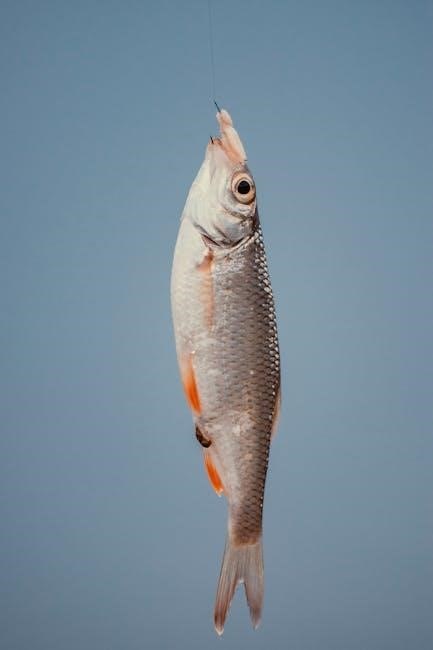
Action, Power, and Length of Fishing Rods
Action, power, and length are key factors in selecting a fishing rod. Action determines flexibility, power indicates strength, and length affects casting distance and accuracy. These elements combine to enhance performance for specific fishing techniques and target species.
3.1 Understanding Rod Action: Fast, Medium, and Slow
Rod action refers to how much a fishing rod flexes when pressure is applied. Fast action rods bend primarily near the tip, offering excellent sensitivity and quick hook-setting power, ideal for lure fishing. Medium action rods flex in the upper half, providing a balance between sensitivity and strength, making them versatile for various techniques. Slow action rods bend throughout their length, allowing for more play when fighting fish, reducing the likelihood of pulling hooks. Each action type caters to different fishing styles, target species, and personal preferences, ensuring anglers can choose the best tool for their specific needs.
3.2 Rod Power: Ultra-Light to Extra-Heavy
Rod power indicates the rod’s strength and ability to handle specific line weights and fish sizes. Ultra-light rods are designed for small fish and delicate presentations, using light lines. Light to medium power rods offer versatility for general fishing, while medium-heavy to heavy power rods are suited for larger species and heavier lines. Extra-heavy rods are built for battling large, powerful fish in demanding conditions. Matching the rod’s power to the target species ensures efficient fishing and reduces the risk of breakage. Proper power selection enhances control, leverage, and overall performance, making it a critical factor in choosing the right fishing rod for any scenario.
3.3 Selecting the Right Rod Length for Your Fishing Style
Rod length is a critical factor in determining performance and comfort. Longer rods (7-10 feet) excel in casting distance and leverage, ideal for saltwater fishing or targeting larger species. Shorter rods (5-6 feet) offer better control and sensitivity, perfect for panfish, ice fishing, or tight spaces. Medium-length rods (6-7 feet) provide a balance, making them versatile for general freshwater fishing. Consider your fishing style, target species, and environment to choose the optimal length. The right length enhances accuracy, reduces fatigue, and improves overall fishing efficiency, ensuring a more enjoyable and successful experience on the water.
Materials Used in Fishing Rod Construction
Fishing rods are made from Fiberglass, Graphite, or Composite materials, each offering unique benefits for durability, sensitivity, and performance. These materials are carefully chosen to balance strength, flexibility, and weight, ensuring optimal fishing experiences across various conditions.
4.1 Fiberglass Rods: Durability and Versatility
Fiberglass rods are known for their exceptional durability and versatility, making them a reliable choice for anglers. They are often referred to as “old reliable” in the fishing world due to their strength and resistance to wear. Fiberglass is a great option for beginners, as it is more forgiving and less prone to breakage. These rods excel in saltwater and brackish environments, where corrosion resistance is crucial. While they may lack the sensitivity of graphite rods, their robust construction and ability to withstand harsh conditions make them ideal for heavy-duty fishing applications. Fiberglass rods are also cost-effective and long-lasting, offering excellent value for anglers seeking a durable option.
4.2 Graphite Rods: Sensitivity and Performance
Graphite rods are renowned for their exceptional sensitivity and performance, making them a preferred choice for anglers seeking precision. Their lightweight construction allows for better feel, enabling anglers to detect even the slightest bites. Graphite rods are particularly effective in freshwater fishing, especially for species like trout, due to their fast action and responsiveness. The fast action means the rod bends primarily near the tip, facilitating quick hook sets and accurate casting. Despite their lighter weight, graphite rods can handle larger fish with ease. Their sensitivity and performance make them ideal for anglers who value precision and control in their fishing experience.
4.3 Composite Rods: Combining the Best of Both Worlds
Composite rods blend graphite and fiberglass, offering a balance of sensitivity and durability. They provide the responsiveness of graphite and the strength of fiberglass, making them versatile for various fishing conditions. These rods excel in both freshwater and saltwater environments, offering consistent performance. Their durability ensures longevity, while their sensitivity allows anglers to detect subtle bites. Composite rods are ideal for anglers seeking a rod that can handle multiple fishing techniques and species without compromising on quality or performance. This hybrid approach ensures a rod that is both robust and responsive, catering to a wide range of fishing needs and preferences.
Choosing the Right Rod for Your Fishing Needs
Selecting the ideal rod involves considering fish species, fishing technique, and environment. Match rod action, power, and length to your target fish and fishing style for optimal results.
5.1 Freshwater Fishing Rods: Specifics and Recommendations
Freshwater fishing rods are tailored for specific species and techniques. Graphite rods excel in sensitivity, ideal for detecting subtle bites from trout or panfish, while fiberglass offers durability for larger species. Fast-action rods are perfect for lure fishing, providing quick hook sets, especially for bass and walleye. Medium to slow-action rods suit live bait or bottom fishing, allowing fish to take the bait before setting the hook. Rod lengths typically range from 5 to 8 feet, with longer rods improving casting distance and shorter rods enhancing accuracy. Ultra-light to medium power rods are versatile, handling everything from small panfish to larger game fish effectively.
5.2 Saltwater Fishing Rods: Design and Material Considerations
Saltwater fishing rods are built for durability and strength to handle the harsh marine environment. They often feature corrosion-resistant guides and reel seats to withstand saltwater exposure. Graphite rods are popular for their sensitivity and ability to detect bites from species like trout or panfish, while fiberglass rods offer exceptional durability, ideal for larger species. Fast-action rods are preferred for lure fishing, providing quick hook sets, especially for bass and walleye. Medium to slow-action rods are better suited for live bait or bottom fishing, allowing fish to take the bait before setting the hook. Rod lengths typically range from 5 to 8 feet, with longer rods improving casting distance and shorter rods enhancing accuracy. Ultra-light to medium power rods are versatile, handling everything from small panfish to larger game fish effectively.
5.3 Fly Fishing Rods: Unique Characteristics and Setup
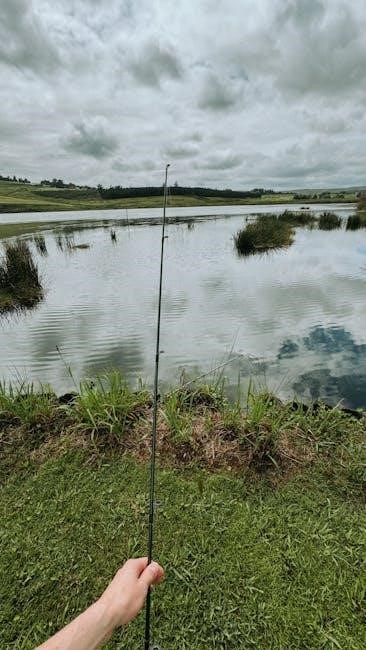
Fly fishing rods are designed for precision and delicacy, with lightweight materials like graphite or bamboo. They feature a slower action, allowing for smooth casting and presenting flies naturally. Fly rods typically range from 7 to 9 feet, with line weights matched to target species. The setup includes a fly reel, line, leader, and tippet, all carefully balanced for optimal casting. Guides are strategically placed to minimize line friction, enhancing casting distance and accuracy. Proper setup ensures effective presentation of flies, whether nymphing, dry fly fishing, or streamer fishing, making them essential for anglers targeting trout, salmon, or other species in freshwater and saltwater environments.
5.4 Ice Fishing Rods: Compact and Sensitive Designs
Ice fishing rods are specifically designed for cold-weather conditions, offering compact, lightweight, and highly sensitive constructions. They typically range from 24 to 36 inches in length, allowing for precise control in tight spaces. Ultra-light to medium power ratings ensure detection of even the slightest bites, crucial in icy waters where fish activity is subdued. These rods often feature durable, weather-resistant materials and minimal guides to reduce ice buildup. Their shorter length and balanced design enable anglers to feel subtle movements, making them ideal for targeting species like walleye, perch, and panfish through ice-covered lakes and rivers.
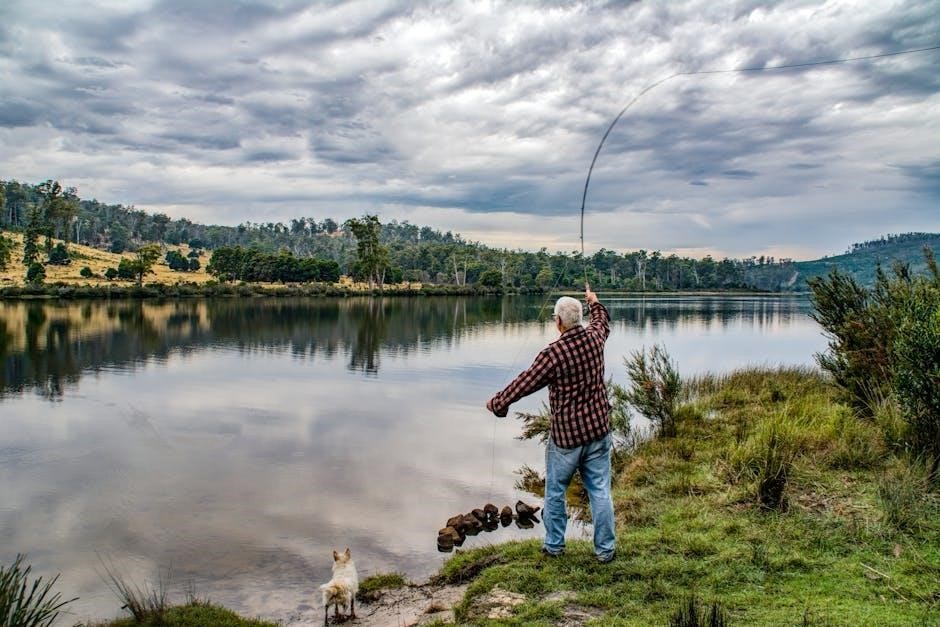
The Role of Guides on a Fishing Rod
Fishing rod guides ensure smooth line flow, reduce friction, and distribute stress during casts and fights, enhancing casting distance and sensitivity for a better fishing experience.
6.1 Types of Guides: Single Foot, Double Foot, and More

Fishing rod guides come in various types, each designed for specific fishing needs. Single-foot guides are lightweight and ideal for light tackle, offering sensitivity and ease of use. Double-foot guides are sturdier, providing durability and better line control, often used in heavy-duty fishing. Micro guides are smaller, reducing weight and improving casting accuracy, while titanium guides offer exceptional strength and corrosion resistance. The choice of guide type depends on fishing style, target species, and environmental conditions, ensuring optimal performance and longevity of the rod.
6.2 Guide Size and Spacing: Optimizing Line Flow and Sensitivity
Guide size and spacing are critical for optimizing line flow and sensitivity. Smaller guides reduce weight and improve casting accuracy, while larger guides provide durability for heavy lines. Proper spacing ensures even line distribution, enhancing sensitivity and reducing friction. Strategic placement near the tip increases responsiveness, allowing anglers to feel subtle bites. Even spacing also improves casting performance by maintaining consistent energy transfer. Balancing guide size and spacing ensures the rod’s overall balance, translating to better control and precision during fishing. This optimization is vital for maximizing the rod’s performance in various fishing conditions and techniques.
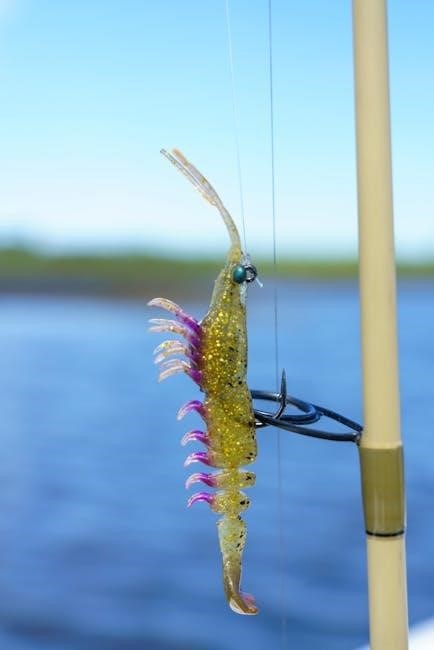
Maintenance and Care of Your Fishing Rod
Regular cleaning, proper storage, and avoiding harsh chemicals are essential for maintaining your fishing rod. Store it in a protective case to prevent damage and extend its lifespan.
7.1 Cleaning and Storing Your Rod Properly
Cleaning your fishing rod regularly is essential to maintain its performance and durability. Use a soft cloth and mild soap to wipe down the rod blank, guides, and reel seat. Avoid harsh chemicals or abrasive materials that can damage the finish or components. After cleaning, dry the rod thoroughly to prevent moisture buildup. Store your rod in a protective case or sleeve to shield it from dust and accidental damage. For extended storage, keep the rod in a cool, dry place, away from direct sunlight to prevent warping or discoloration. Proper storage ensures your rod remains in prime condition for future use.
7.2 Inspecting and Replacing Damaged Guides
Regularly inspect your rod guides for damage, such as nicks, cracks, or bent frames, which can hinder performance. Use a magnifying glass to check for wear. If damage is found, replace the guide promptly to prevent line tangles or breaks. To replace a guide, cut the thread above and below the damaged guide, remove it, and install a new one using rod wrapping thread. Ensure the new guide is securely wrapped and epoxy-coated for durability. Properly aligned and functioning guides are critical for smooth line flow and sensitivity. Addressing guide issues early ensures optimal rod performance and extends its lifespan.
7.3 Tips for Long-Term Durability and Performance
To ensure your fishing rod remains durable and performs optimally, avoid exposing it to extreme temperatures or direct sunlight for prolonged periods. Store it in a protective case or sleeve to prevent scratches and damage during transport. Handle the rod gently, as rough handling can weaken the blank or misalign guides. After fishing, wipe down the rod with a soft cloth to remove dirt and moisture. Avoid using harsh chemicals, as they may damage the finish or components. Finally, periodically check the alignment of your guides and ensure they are free from debris. Proper care extends the life of your rod and maintains its performance.
Investing time in selecting and maintaining a quality fishing rod is worthwhile. A well-designed guide enhances your fishing experience, ensuring success and enjoyment. Understanding and caring for your rod guarantees memorable fishing moments.

8.1 Final Thoughts on Selecting and Maintaining Your Fishing Rod
Selecting the right fishing rod requires careful consideration of your fishing style, target species, and environmental conditions. Whether you prefer fiberglass, graphite, or composite materials, ensure your rod aligns with your needs for sensitivity and durability. Proper maintenance, including regular cleaning and storing, is essential to extend the life of your rod. Inspect guides and reels regularly, and replace damaged components promptly. A well-maintained rod not only enhances performance but also ensures reliability during critical moments on the water. By investing time in selection and care, you can maximize your fishing experience and create lasting memories.

8.2 The Impact of a Quality Rod on Your Fishing Experience
A quality fishing rod significantly enhances your fishing experience by providing precision, sensitivity, and durability. It allows for better line control, smoother casts, and quicker hook sets, making every bite more detectable. A well-crafted rod also reduces fatigue during long fishing sessions and ensures consistent performance in various conditions. Whether you’re targeting small trout or large game fish, a reliable rod builds confidence and improves your overall success rate. Investing in a high-quality rod is not just about the gear—it’s about elevating the enjoyment and effectiveness of your time on the water, creating a more rewarding and memorable fishing adventure.
